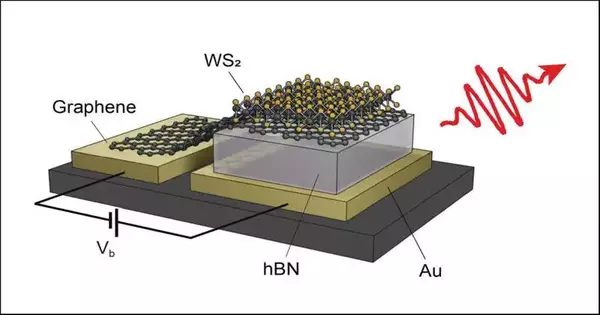Modern data transfer, in which data is transmitted in the form of modulated light beams through fiber optic cables, is based, among other things, on the rapid switching and modulation of light. Light-emitting diodes (LEDs) and lasers still present challenges for engineers, despite the fact that light modulators have been miniaturized and integrated into chips for a number of years.
Researchers led by Prof. Lukas Novotny at ETH Zurich, along with colleagues at EMPA in Dübendorf and ICFO in Barcelona, have discovered a new method for the future production of tiny but effective light sources. The journal Nature Materials recently published their research’s findings.
Trying the unexpected
“We first had to try the unexpected to achieve this,” says Novotny. He and his coworkers have been developing tunnel-effect-based miniature light sources for several years. According to quantum mechanics, electrons can tunnel between two electrodes, in this case made of gold and graphene, separated by an insulating material. Light can be produced under certain conditions—namely, if the tunnel process is inelastic, which indicates that the electrons’ energy is not conserved.
“At the moment, this antenna is not very good because dark excitons are created inside the semiconductor, which means that not much light is emitted. Improving this will be our assignment for the foreseeable future.”
Prof. Lukas Novotny,
Postdoc Sotirios Papadopoulos provides the following explanation: “Unfortunately, the yield of those light sources is rather poor because the radiative emission is very inefficient.” This issue with emissions is well known in other technological fields. For instance, the microwaves that are required for transmission are produced by chips that are only a few millimeters in size in mobile phones.
In contrast, the microwaves themselves are a hundred times larger than the chip and have a wavelength of around 20 centimeters. An antenna, which is no longer visible from the outside of modern phones, is required to overcome this size difference. Similarly, the Zurich researchers’ experiments show that the light’s wavelength is significantly longer than the light source.
Outside the tunnel junction, a semiconductor states,
“One might think, then, that we were consciously looking for an antenna solution—but in reality we weren’t.” In order to produce light in this manner, the researchers were looking into layers of semiconductor materials like tungsten disulfide with a thickness of one atom sandwiched between the tunnel junction’s electrodes, just like other groups before them.
The ideal position would, in principle, be somewhere in between the two electrodes, perhaps a little closer to one than the other. Instead, the researchers tried putting the semiconductor on top of the graphene electrode—completely outside the tunnel junction—and this was a completely different approach.
Surprising antenna action
Despite its apparent absurdity, this position proved to be very effective. By varying the voltage applied to the tunnel junction and measuring the current flowing through it, the researchers discovered the reason for this. This measurement revealed a distinct resonance that corresponded to the semiconductor material’s so-called exciton resonance.
A positively charged hole and an electron bound by the hole make up excitons, which represent electrons that are missing. Light irradiation, for instance, has the potential to excite them. Since there were no electrons passing through the semiconductor, the exciton resonance was a clear indication that it was absorbing the energy generated in the tunnel junction and then re-emitting it rather than being directly excited by charge carriers. To put it another way, it behaved very similarly to an antenna.
Applications in nanoscale light sources
“For the time being, this antenna is not very good because so-called dark excitons are created inside the semiconductor, which means that not much light is emitted,” Novotny acknowledges. Our upcoming homework will be to improve this. Light sources that are a thousand times smaller than the wavelength of the light they produce should be possible to construct if the researchers are successful in increasing the semiconductor’s efficiency in emitting light.
The semiconductor antenna does not experience any of the undesirable effects that typically occur at boundaries and have the potential to reduce efficiency because there are no electrons moving through it. Regardless, we have made a way for new applications,” says Novotny. It is evident that attempting the unexpected paid off.
More information: Lujun Wang et al, Exciton-assisted electron tunnelling in van der Waals heterostructures, Nature Materials (2023). DOI: 10.1038/s41563-023-01556-7





